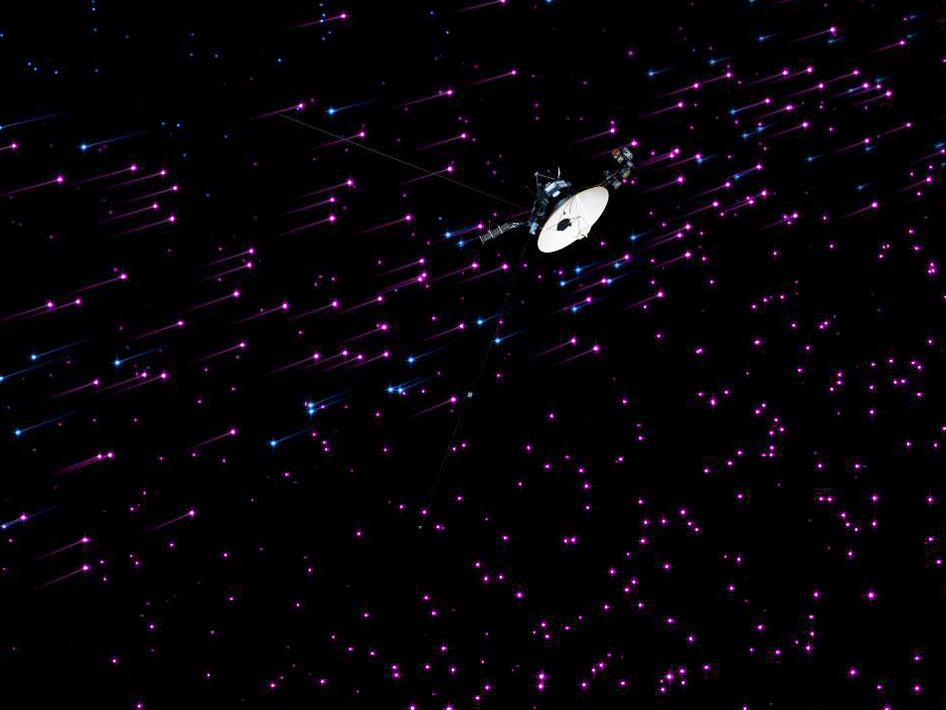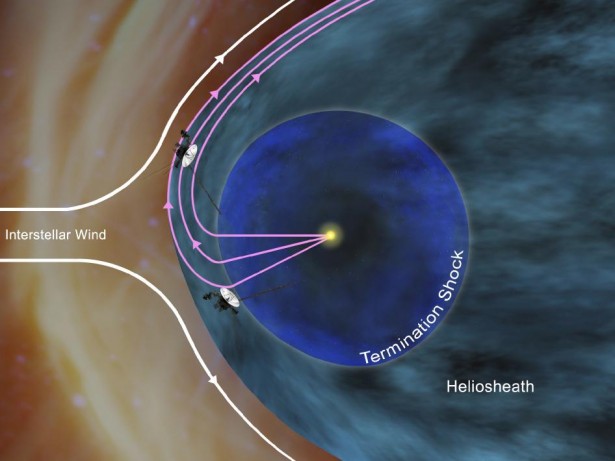NASA’s Voyager 1 enters new region of deep space – magnetic highway

NASA scientists have announced entry of Voyager 1 in a new region in deep space, which they’re calling a magnetic highway for charged particles; presumably the last leg of Voyager mission’s journey. In this region, magnetic field lines of sun are found connected to those of interstellar origin allowing lower-energy charged particles from inside our heliosphere to rush out and high energy particles form outside to stream in. As per scientists, particles were found trapped and bouncing around in all directions prior entering this region.
Prior to this official announcement, there were estimates that Voyager 1 might have already left our solar system. But according to mission team, direction of magnetic field lines has not changed, which means this region is not beyond heliosphere. Direction of these magnetic field lines is predicted to change when Voyager breaks through to interstellar space. Edward Stone, Voyager project scientist based at the California Institute of Technology, Pasadena said,
“Although Voyager 1 still is inside the sun’s environment, we now can taste what it’s like on the outside because the particles are zipping in and out on this magnetic highway. We believe this is the last leg of our journey to interstellar space. Our best guess is it’s likely just a few months to a couple of years away. The new region isn’t what we expected, but we’ve come to expect the unexpected from Voyager.”
This set of animations show NASA’s Voyager 1 spacecraft exploring a new region in our solar system called the “magnetic highway.” In this region, the sun’s magnetic field lines are connected to interstellar magnetic field lines, allowing particles from inside the heliosphere to zip away and particles from interstellar space to zoom in.
Voyager 1 crossed a point in space called the termination shock in 2004 and has been exploring the heliosphere’s outer layer ever since, called the heliosheath. In this region, the stream of charged particles from the sun, known as the solar wind, abruptly slowed down from supersonic speeds and became turbulent. Voyager 1’s environment was consistent for about five and a half years. The spacecraft then detected that the outward speed of the solar wind slowed to zero. Intensity of the magnetic field was also found to have increased at that time.
Voyager data from two on board instruments that measure charged particles showed the spacecraft first entered this magnetic highway region on July 28, 2012. The region ebbed away and flowed toward Voyager 1 several times. The spacecraft entered the region again August 25 and the environment has been stable since. Spacecraft data revealed the magnetic field became stronger each time Voyager entered the highway region; however, direction of the magnetic field lines did not change. Stamatios Krimigis, principal investigator of the low-energy charged particle instrument, based at the Johns Hopkins Applied Physics Laboratory, Laurel, Md. said,
“If we were judging by the charged particle data alone, I would have thought we were outside the heliosphere. But we need to look at what all the instruments are telling us and only time will tell whether our interpretations about this frontier are correct.”
 This artist’s concept shows how NASA’s Voyager 1 spacecraft is bathed in solar wind from the southern hemisphere flowing northward. This phenomenon creates a layer just inside the outer boundary of the heliosphere, the giant bubble of solar ions surrounding the sun. If the outside pressure were symmetrical, the streams from the sun’s northern hemisphere above the plane of the planets would all turn northward and the streams from the southern hemisphere would all turn southward. Image credit: NASA/JPL-Caltech
This artist’s concept shows how NASA’s Voyager 1 spacecraft is bathed in solar wind from the southern hemisphere flowing northward. This phenomenon creates a layer just inside the outer boundary of the heliosphere, the giant bubble of solar ions surrounding the sun. If the outside pressure were symmetrical, the streams from the sun’s northern hemisphere above the plane of the planets would all turn northward and the streams from the southern hemisphere would all turn southward. Image credit: NASA/JPL-Caltech
Leonard Burlaga, a Voyager magnetometer team member based at NASA’s Goddard Space Flight Center in Greenbelt, Md. said,
“We are in a magnetic region unlike any we’ve been in before — about 10 times more intense than before the termination shock — but the magnetic field data show no indication we’re in interstellar space. The magnetic field data turned out to be the key to pinpointing when we crossed the termination shock. And we expect these data will tell us when we first reach interstellar space.”
Voyager 1, after completing its 35 years in space, is at an approximate distance of 18 billion kilometers. It is the farthest spacecraft, rather a man-made object from earth. Its companion, Voyager 2 is 3 billion kilometers behind. The signal from Voyager 1 takes approximately 17 hours to travel to Earth.
Source: NASA
Featured image: Voyager 1 Explores the ‘Magnetic Highway’
This still image and set of animations show NASA’s Voyager 1 spacecraft exploring a new region in our solar system called the “magnetic highway.” In this region, the sun’s magnetic field lines are connected to interstellar magnetic field lines, allowing particles from inside the heliosphere to zip away and particles from interstellar space to zoom in. Image credit: NASA/JPL-Caltech

Commenting rules and guidelines
We value the thoughts and opinions of our readers and welcome healthy discussions on our website. In order to maintain a respectful and positive community, we ask that all commenters follow these rules.